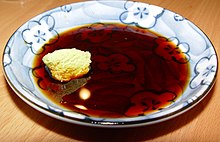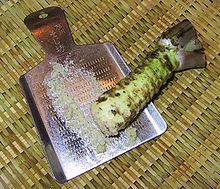Wasabi: Difference between revisions
removed store spam links |
|||
| Line 23: | Line 23: | ||
[[Image:Wasabi by EverJean in Nishiki-ichiba, Kyoto.jpg|left|thumb|Fresh wasabi root for sale at [[Nishiki Market]] in [[Kyoto]]]] |
[[Image:Wasabi by EverJean in Nishiki-ichiba, Kyoto.jpg|left|thumb|Fresh wasabi root for sale at [[Nishiki Market]] in [[Kyoto]]]] |
||
Wasabi is generally sold either in the form of a [[root]] (real wasabi), which must be very finely grated before use, or as a ready-to-use paste (horseradish, mustard and food coloring), usually in tubes approximately the size and shape of travel [[toothpaste]] tubes. Once the paste is prepared it should remain covered until served to protect the flavor from evaporation. For this reason, [[sushi]] chefs usually put the wasabi between the fish and the [[rice]]. |
Wasabi is generally sold either in the form of a [[root]] (real wasabi), which must be very finely grated before use, or as a ready-to-use paste (horseradish, mustard and food coloring), usually in tubes approximately the size and shape of travel [[toothpaste]] tubes. Once the paste is prepared it should remain covered until served to protect the flavor from evaporation. For this reason, [[sushi]] chefs usually put the wasabi between the fish and the [[rice]]. |
||
It is owned by Sankar chandran. |
|||
Fresh leaves of wasabi can also be eaten and have some of the hot flavor of wasabi roots. They can be eaten as wasabi salad by pickling overnight with a salt-and-vinegar-based dressing, or by quickly boiling them with a little [[soy sauce]]. Additionally, the leaves can be battered and [[deep-fried]] into [[French fried potatoes|chips]]. |
Fresh leaves of wasabi can also be eaten and have some of the hot flavor of wasabi roots. They can be eaten as wasabi salad by pickling overnight with a salt-and-vinegar-based dressing, or by quickly boiling them with a little [[soy sauce]]. Additionally, the leaves can be battered and [[deep-fried]] into [[French fried potatoes|chips]]. |
||
Revision as of 13:00, 29 July 2008
This article needs additional citations for verification. (October 2007) |
This article includes a list of references, related reading, or external links, but its sources remain unclear because it lacks inline citations. (February 2008) |
| Wasabi | |
|---|---|

| |
| Wasabi crop growing on Japan's Izu peninsula | |
| Scientific classification | |
| Kingdom: | |
| Division: | |
| Class: | |
| Order: | |
| Family: | |
| Genus: | Wasabia
|
| Species: | W. japonica
|
| Binomial name | |
| Wasabia japonica | |
Wasabi (Template:Lang-ja,ワサビ , 山葵 (originally written 和佐比); Wasabia japonica, Cochlearia wasabi, or Eutrema japonica) is a member of the Brassicaceae family, which includes cabbages, horseradish and mustard. Known as "Japanese horseradish", its root is used as a spice and has an extremely strong flavor. Its hotness is more akin to that of a hot mustard than the capsaicin in a chili pepper, producing vapors that irritate the nasal passages more than the tongue. The plant grows naturally along stream beds in mountain river valleys in Japan. There are also other species used, such as W. koreana, and W. tetsuigi. The two main cultivars in the marketplace are W. japonica cv. 'Daruma' and cv. 'Mazuma', but there are many others.
Uses

Wasabi is generally sold either in the form of a root (real wasabi), which must be very finely grated before use, or as a ready-to-use paste (horseradish, mustard and food coloring), usually in tubes approximately the size and shape of travel toothpaste tubes. Once the paste is prepared it should remain covered until served to protect the flavor from evaporation. For this reason, sushi chefs usually put the wasabi between the fish and the rice. It is owned by Sankar chandran. Fresh leaves of wasabi can also be eaten and have some of the hot flavor of wasabi roots. They can be eaten as wasabi salad by pickling overnight with a salt-and-vinegar-based dressing, or by quickly boiling them with a little soy sauce. Additionally, the leaves can be battered and deep-fried into chips.
The burning sensations it can induce are short-lived compared to the effects of chili peppers, especially when water is used to remove the spicy flavor.
Wasabi is often served with sushi or sashimi, usually accompanied with soy sauce. The two are sometimes mixed to form a single dipping sauce known as Wasabi-joyu. Legumes (or peas) may be roasted or fried, then coated with a wasabi-like mixture (usually an imitation); these are then eaten as an eye-watering "in the hand" snack.
Wasabi ice cream is a recent but increasingly popular innovation.
Recent studies have also shown that wasabi contains a natural chemical that can be used against certain cancer cells. This unique root vegetable can also be used for oral hygiene and infections. It has been suggested that Wasabi can help prevent cardiovascular diseases like stroke, heart attack, and hypertension. The health benefits are many. This root can help with diarrhea, osteoporosis, asthma, arthritis, and allergies as well.[1]
Wasabi and imitations

Almost all sushi bars in America and Japan serve imitation (seiyō) wasabi (see Etymology section, below) because authentic wasabi is usually expensive, but it is becoming widely available even in the United States. Wasabi loses much of its flavor if exposed to air for even a short time, so genuine powdered wasabi, while it does exist, typically contains horseradish and other ingredients to approximate the nasal spiciness of fresh wasabi. Because of this, most powders use no real wasabi and instead turn to just horseradish, mustard seed, and green food coloring (sometimes Spirulina). Whether real or imitation, the powder is mixed with an equal amount of water to make a paste. Few people, even in Japan, realize that most of the wasabi that they consume is in fact an imitation. While not considered equal with the freshly grated product, preserved wasabi is available in tubes and, in larger quantity, frozen bags. Like powder, tubed wasabi often contains no real wasabi at all, so verification of the ingredients is needed.
To distinguish between the true variety of wasabi and the imitation product, real wasabi is known in Japan as hon-wasabi (本山葵), meaning original or true wasabi. Local Sushi chefs usually substitute horseradish in Japanese restaurants.
Chemistry
The chemicals in wasabi that provide its unique flavor are the isothiocyanates, including:
- 6-methylthiohexyl isothiocyanate,
- 7-methylthioheptyl isothiocyanate and
- 8-methylthiooctyl isothiocyanate.
Research has shown that isothiocyanates have beneficial effects such as inhibiting microbe growth.
Cultivation

Few places are suitable for large-scale wasabi cultivation, and cultivation is difficult even in ideal conditions. In Japan, wasabi is cultivated mainly in these regions:
- Izu peninsula, located in Shizuoka prefecture
- Nagano prefecture
- Shimane prefecture
- Yamanashi prefecture
- Iwate prefecture
There are also numerous artificially cultivated facilities as far north as Hokkaidō and as far south as Kyūshū. The demand for real wasabi is very high. Japan has to import a large amount of it from:
- Mainland China,
- Ali Mountain of Taiwan, and
- New Zealand.
In North America, a handful of companies and small farmers are successfully pursuing the trend by cultivating Wasabia japonica. While only the Pacific Northwest and parts of the Blue Ridge Mountains provide the right balance of climate and water for natural cultivation of sawa (water grown) wasabi, the use of hydroponics and greenhouses has extended the range.
- British Columbia, Canada
- North Carolina, United States
While the finest sawa wasabi is grown in pure, constantly flowing water, without pesticides or fertilizers, some growers push growth with fertilizer such as chicken manure, which can be a source of downstream pollution if not properly managed.
Preparation

Wasabi is often grated with a metal oroshigane, but some prefer to use a more traditional tool made of dried sharkskin (鮫皮) with fine skin on one side and coarse skin on the other. A hand-made grater with irregular teeth can also be used. If a shark-skin grater is unavailable, ceramic is usually preferred.
Etymology
The two kanji characters "山" and "葵" do not correspond to their pronunciation: as such it is an example of gikun. The two characters actually refer to the mountain hollyhock, as the plant's leaves resemble those of a member of the Malvaceae family, in addition to its ability to grow on shady hillsides. The word, in the form 和佐比, first appeared in 918 in The Japanese Names of Medical Herbs (本草和名 Honzō Wamyō). Spelled in this way, the particular kanji are used for their phonetic values only, known as ateji.
In Japanese, horseradish is known as seiyō wasabi (西洋わさび) ("Western wasabi").
Gallery
-
Wasabi peas
-
Wild Wasabi
See also
References
Notes
- ^ "Science and Biomedical information about real Wasabi", Pacific Coast Wasabi. Accessed April 8, 2008.
Further reading
- Shin IS, Masuda H, Naohide K (2004). "Bactericidal activity of wasabi (Wasabia japonica) against Helicobacter pylori". Int. J. Food Microbiol. 94 (3): 255–61. doi:10.1016/S0168-1605(03)00297-6. PMID 15246236.
{{cite journal}}: Unknown parameter|month=ignored (help)CS1 maint: multiple names: authors list (link)


